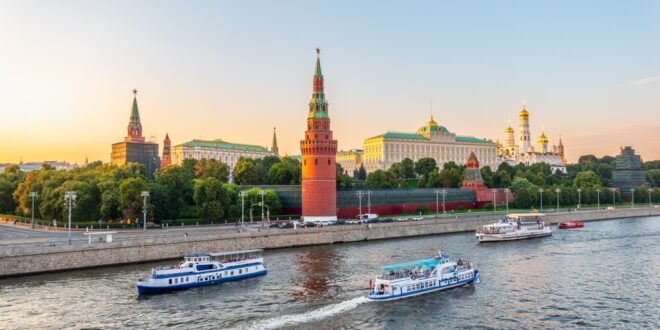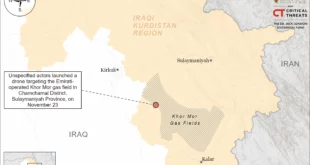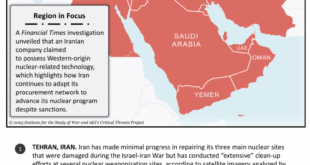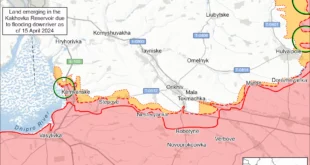Previously marginal revanchist intellectuals have been producing grandiose ideological theorisations, that are now at the core of state-sanctioned narratives legitimising Russia’s invasion of Ukraine. There is however little evidence that the “hawks” can effectively constrain the Kremlin’s policy choices
With Russia’s invasion of Ukraine, a new set of keywords entered the Kremlin’s vocabulary. Expressions such as “collective West” and “denazification” were never used – not a single time – in the tens of thousands of press releases and speeches published on the Kremlin’s website before 2021, but they featured routinely since then.
After text-mining the websites of different state institutions and mainstream media, I found that these expressions barely featured in any of these sources before they were picked up by the Kremlin, but became commonplace afterwards. Where did such expressions come from? Were they really originally conceived by the Kremlin as the rhetorical companions of the military plans for invading Ukraine? Or had they been brewing for years in previously marginal cultural environments before entering the public spotlight? As it turned out, there was one source where “collective West ” and “denazification ” had been featuring regularly in articles for years: Zavtra, a weekly broadsheet newspaper in print since the 1990s.
I first read Zavtra in the early 2000s; its articles were edgy and full of verve, very much unlike all other publications I could buy at newsstands in provincial Russia at the time. Zavtra’s articles were imbued with revanchism, featured scathing critique of politicians and public figures, and were obviously out of tune with both official rhetoric and mainstream public discourse. Partly because of its seemingly home-made bulging logo, I dismissed it as an oddity of the transition due to disappear as its founder – Alexander Prokhanov, a very public supporter of the failed 1991 August coup against Gorbachev – aged into oblivion. I was young and naive, and, with the benefit of hindsight, obviously wrong.
Looking at the results of my content analysis many years later, I was still surprised to find that the cultural and ideological circles authoring rabid articles for a fringe publication such as Zavtra could become direct source of inspiration for the Kremlin’s speech-writers. Even accepting that Zavtra itself may not be so influential, in the present context there’s good reason to take the adoption of these buzzwords as an invitation to dedicate more attention to the ideological and cultural spaces that have grown around Zavtra and its founder. As emerges from an excellent book by Juliette Faure recently published with Cambridge University Press – The Rise of the Russian Hawks: Ideology and Politics from the Late Soviet Union to Putin’s Russia – this is a surprisingly rich and engrossing story, that illustrates how generations of writers and intellectuals with often conflicting views built a coalition promoting their shared vision of “modernist conservatism” among policy circles.
Juliette Faure analyses the development of the idea network she calls the “Russian hawks” highlighting the continuity of debates around Russian modernist conservatism from the 1960s through the late Soviet years to the present days. In reaction to “a developmental path shared with the West and leading to the two systems’ ultimate convergence” emerging already in Soviet times, “they connected elements of paradigms formerly held as incompatible, including Soviet technoscientific modernity, religious Russophile conservatism, and Stalinian state patriotism.”
This cohort of public intellectuals found inspiration in earlier writings associated with “Russian cosmism” and a spiritual approach to technological progress. Cultural points of reference included Nikolai Fedorov (1829–1903), who had proposed a model of “active Christianity”, whereby “technological progress would usher in a new age where humanity was able to regulate the cosmos and realize the promises of the Bible, including transforming human nature toward its deification.” According to this philosophical current, Biblical concepts such as life extension, resuscitation and immortality were not to be understood metaphorically, but could and should be achieved not only through spiritual, but also technological progress.
Reading about these ideas in 2025, one may easily find all sorts of connections with contemporary debates, from “AI” fantasies of all-intelligent humans to Vladimir Putin talking with Xi Jinping about how technology and transplantation of human organs could lead to immortality .
Contemporary Russian intellectuals associated with this group insist that technological progress and Orthodox Christianity are both central to their conservative vision, overcoming a stereotyped fetishisation of a distant rural past. Indeed, Russian modernist conservatism combines a rather eclectic mix of ideas and public figures that for a long time could not overcome their internal disagreements, yet eventually emerged as a “collective language coalescing various groups and generations united by their common opposition to Russia’s convergence with the West.” United by their common struggle against liberal reformists and favouring group identity-building over theoretical consistency, they united with younger proponents of “dynamic conservatism” in order to form an organisational network that could effectively reach policy-making circles. The coalescing of this idea network into a formal organisation actively seeking to influence state policy, the Izborskii Klub, founded in 2012, had among its key figures and as its first president Alexander Prokhanov, director of Zavtra. Prokhanov not only did not age into oblivion, as my younger self assumed, but well into his 80s, after Russia’s invasion of Ukraine, has been receiving official state honours and was publicly acknowledged by Vladimir Putin , who demonstrated familiarity with his writing.
Shaping policies or legitimising them?
Looking at the prominent role of ideology in official discourse in Russia and the extent to which the worldview expressed by the Kremlin aligns with those of the “Russians Hawks”, it may be tempting to conclude that indeed, their hard ideological and organisational work has paid off, and they finally managed to influence state policy. Zavtra itself on its official website boasts that “over the years, we at Zavtra have created several ideologies, several powerful trends that have entered and continue to enter the public consciousness.”
In practice, however, the adherence of the Kremlin’s policy with the views expressed by Zavtra and the Izborskii Klub, has been all but steadfast. Indeed, the views expressed by Zavtra have been marginalised throughout the early 2000s, briefly co-opted in 2014 to legitimise the annexation of Crimea and the potential expansion of political objectives towards “Novorossiya ”, but soon sidelined again as the Kremlin’s inched towards turning the Donbas into a more conventional “frozen conflict” rather than a highly ideologised frontline (the “Russian Hawks” were lobbying in favour of a more expansive military intervention and a more assertive position towards Ukraine and the West already in 2014).
As Faure argues, what the Kremlin has been doing is to favour “managed ideological pluralism”, promoting or demoting different idea networks, ensuring that “a range of lines and narratives [would be] available to justify various policy courses.” At times, the views expressed by Prokhanov and his peers have proved to be useful to the Kremlin, and they have been picked up, à la carte, from among available policy options; at others, they have been unceremoniously dismissed.
How much does ideology really matter?
The account offered by Juliette Faure of how radical thought coalitions emerged and evolved through recent decades taking increasingly purposeful efforts to get closer to policy-making circles is gripping and convincing. Faure posits that “ideology plays a pivotal role within the Russian political system by shaping the collective language constitutive of elite groups”; “the competition of these groups, in turn, shapes the set of policy options available.” My own research confirms that indeed, some of the most prominent keywords that accompanied Russia’s invasion of Ukraine have originated in the cultural and intellectual spaces described in Faure’s book.
And yet, even acknowledging that they served as inspiration for official and public discourse, it is less clear that they did actually influence policy options. Besides, if we accept Jeremy Morris’ view that “any national ideology [in Russia] is skin deep, and certainly most elites are entirely cynical, if not incredulous at pretensions about expanding the ‘Russian World’”, we must also question how relevant these ideological debates really are for understanding contemporary Russian politics and, more specifically, the Kremlin’s motivations for invading Ukraine.
Surely, Putin’s own radicalisation journey has not happened in a void. His thinking may well have been shaped more by Soviet-time stereotypes and spy-fiction series than by elaborate ideological constructions, but the role of the these intellectual groups in building ideological underpinnings for turning a late-imperial fantasy into state policy should not be dismissed. However, as far as policy options related to war termination or actual negotiation dynamics are concerned, there is little evidence that they can really constrain the Kremlin’s choices.
The “hawks” themselves may well be trying to establish their cultural hegemony but they understand that radicalisation of public discourse in contemporary Russia is a top-down process led by the presidential administration. They have been sidelined in line with political convenience after the annexation of Crimea, and they must be aware that this can happen again; even as the “hawks” are enthused by increasing alignment of the Kremlin with their policies, they express constant worry at conspirators and traitors even in the highest echelons of power willing to reverse course.
Indeed, even more than Ukraine or NATO, it is the changes happening within Russia itself that matter most to these ideologists, who point at Russia’s awakening, the re-discovery of its imperial identity as a distinct civilisation, and internal cleansing as the main priorities. As argued at length on the website of the Izborskii Klub by one of its leading figures, “all the reasons we can name, such as protecting the Donbas, the issue of NATO expansion […] and many others, none of them are decisive factors. […] To put it bluntly, the issue isn’t about bringing the Ukrainian people, our brotherly nation and dear brothers, back into the Russian world. This is merely an external aspect of what’s happening. There is a far deeper trend underlying this. The trend is that until 2022, Russia continued to remain in a quasi-colonial dependency on another civilization. […] For us, what’s most important is that Russia’s cleansing has begun. […]. Ukraine is merely a pretext for a great event. […] What’s most important in this whole story isn’t the course of the special military operation, although it is certainly crucial, but whether the top-down revolution happening within Russia itself will not collapse.”
Conclusions
Enhanced understanding of ideological debates driven by the “Russian Hawks” offers important context for policy-makers trying to understand the potential contours of a settlement to the ongoing war.
Firstly, it emerges clearly that there is no plausible concession that a legitimate Ukrainian leadership could offer in the course of negotiations that would placate these “Russian hawks”, as their ambitions lie at an entirely different level. Of course, the renewed civilisational empire they dream of would subdue Ukraine and re-shape security arrangements in Europe and beyond, but, to this end, specific territorial or administrative compromises are immaterial, if not as the inevitable acknowledgement of the strength of a rejuvenated imperial Russia. Domestic cleansing and ideological consolidation inside Russia’s core are more fundamental.
Finally, it is worth highlighting that even the “hawks” still see the radicalisation of Russia’s society as a “top-down revolution”. In spite of public display of hyper-patriotic narratives, there is little evidence of any actually bottom-up push for maximalist demands, nor any hint that the “Russian hawks” are edging closer to the cultural hegemony they aspire to either among elites or the public at large. The presidential administration continues to define the contours of acceptable public discourse and intellectual debates through mechanisms of managed ideological pluralism, making it possible for the Kremlin to pick legitimising narratives, as if from a buffet of pre-packaged ideological formulas. It is fair to question how resilient this configuration really is, but all sorts of concrete issues – including economic degradation, challenges from the regions, and frontline developments – represent more realistic constraints to the Kremlin’s actions than ideology-driven unrest.
 Eurasia Press & News
Eurasia Press & News



